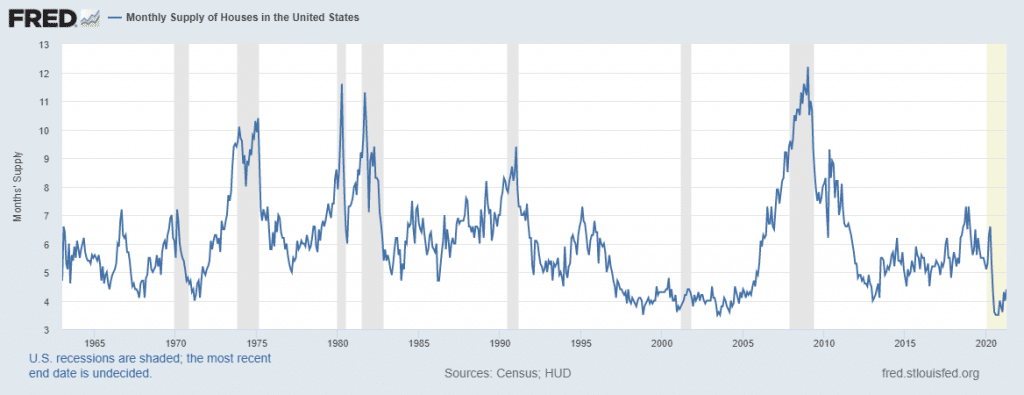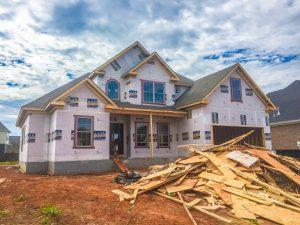
Introduction
It’s no secret that the demand for single-family homes in the United States is greater than the supply. Not only are fewer people selling their homes, but fewer homes are also being built! We must do something, but what? Let’s examine the housing supply problem, and then we’ll discuss several options for solving the issue!
The Building Rate

The building rate of the previous decade struggled to keep up with the pace of the 2000s when homes were being built at nearly twice the rate! From 1993 to 2007, over one million homes were completed per year, ranging from just 1,039,400 to over 1,654,500. The number of constructed homes dropped below the million mark in 2008 for the first time since 1992. And the number continued to slide to a low of 446,600 in 2011. Home production slowly rose to 911,700 in 2020, still significantly lower than the high of the 2000s.
According to Freddie Mac, at the beginning of 2020, the housing supply was short by 2.5 million units. Jump forward to June 2021, and according to the National Association of Realtors, the shortage increased to 5.5 million. Clearly, construction is not keeping up.
Instead of growing to meet the demands of a growing population and shifts in demographics (Millennials and Gen Z’s want houses!), the rate of construction has decreased over the last couple of decades! From 1968 to 2000, the supply of housing increased at an average annual rate of 1.7%. In the past 20 years, the housing stock grew by a low average yearly rate of 1%, and in the last decade, it’s increased by only 0.7%.
In order to fill the underbuilding gap in the next ten years, the NAR estimated that more than two million housing units would need to be built per year – an increase of more than 700,000 units per year relative to the pace of housing production in 2020.
Tim Glaze
As housing prices rise beyond sustainable levels for the average American (see our post, “Will Homeownership Bankrupt Americans”), many of us wonder what the solutions to more affordable homes are. Younger generations are losing hope for the American dream of homeownership. According to a survey by Fannie Mae, in 2019, only 30% of Millennials and Gen Z believed they would be able to find a home in their price range. That’s pretty discouraging! As prices have skyrocketed over the last year and a half, their fears haven’t diminished.
We need more homes built, and quick!
Housing Supply
As we’re all well aware, there just isn’t much out there to buy! Available homes for sale in 2020 dropped to lows not seen since 2003, and the rate is steadily rising, but not fast enough.

Myriad factors contribute to the housing supply crunch. Some of these contributors include the heavy demand for homes from Millennials, the largest group of homebuyers, the 2020 pandemic, tariffs on building supplies, restrictive zoning and permit laws, and the growing population of the United States.
There is a glimmer of hope as building rates are finally picking up in mid-2021. The cost of building supplies is dropping, encouraging contractors to pick up the pace. Is this enough to address the shortage? Can contractors build enough homes to keep up with the demand, let alone catch up?
While the obvious solution is to build more homes, the details that go into the process are complex and difficult. Let’s explore several pieces of the solution.
Tax Incentives

Thirty-four percent of homes in the United States are not owner-occupied. If even a tiny percentage of that supply was made available in the housing market, we could find some relief. Yes, this might cause an unwanted side-effect — a crunch on rental properties — but done right, renters might become owners.
Getting current landlords to sell would take some heavy incentives. The most tempting carrot might be the further implementation of tax exemptions for capital gains. Combine that with tax breaks for first-time homebuyers, renters who want to become owners, and sellers of rental properties who wish to sell, and it just might alleviate some of the supply crunch.
Manufactured Homes
Manufactured homes have had a negative image for decades, but that’s changing. As standards for the quality of building requirements have gone up and studies show that manufactured homes retain their value similar to site-built homes, the image is sporting a newly polished gleam.
Manufactured homes reportedly cost an average of $57 per square foot, whereas site-built homes cost $119 per square foot (although that has likely increased since that article was written). This difference in cost is a promising draw for those looking for cheaper yet appealing alternatives.
A push on manufactured homes, including a robust education campaign for would-be homeowners, could increase the demand for these options.
Build More Homes!
The obvious solution to a shortage is to provide more of the product. But exactly how to do this is the dilemma. Let’s examine several solutions that, when used together, could significantly increase the number of homes being built!
Address the Skilled Labor Deficit

During the Great Recession, approximately 1.5 million construction workers (tradesmen, electricians, carpenters, etc.) either quit or lost their jobs. Over the last decade, about 900,000 workers have returned, but that’s nowhere near enough.
Why aren’t there enough workers to fill the openings at construction companies? Several reasons explain the gap.
First, very few women work in the field. Only nine percent of construction workers are female, and many are in administrative and office positions. Fieldwork is often grueling and open to the elements. Breaking into a male-dominated industry is hard, and the pay and the work aren’t appealing enough to make it worth the difficulty of making those inroads.
Second, getting into the industry and working your way up is often tricky. Many entry-level jobs are unskilled, and the pay shows it. It takes years to work through the ranks and the pay scale. For many, the income simply isn’t worth the grueling work.
As for skilled laborers, training is time-consuming, and many students are unaware that construction is an option. Many schools don’t present construction as a satisfying or well-paying option because it doesn’t always require a college degree. And colleges have done a great job of pushing everyone and anyone into degrees that may not match their ability and skill level.
Lastly, there is a stigma about construction workers in American society, which is often inaccurate and harmful to the industry. Changing the way Americans look at construction jobs and educating students about the benefits and potential for significant income is a step in the right direction. Isn’t it about time that we see an informative commercial from the National Tradesman group?
Make it More Affordable to Build

Lifting Tariffs on Building Supplies
The tariffs levied on Canadian lumber in 2017 and 2018 aren’t the sole cause of the scary-high lumber prices of late 2020 and 2021, but they aren’t helping either. At nine percent, the tariff on Canadian lumber is steep compared to the average tariff of 1.59% for all tariffs imposed on other countries by the United States in 2018. Lowering the tariffs won’t solve the problem, but it would surely help. This option would take some significant changes in the U.S. Commerce Department’s policies though; in May 2021 (despite the insanely high lumber prices) they recommended doubling the tariffs!
Tax Breaks on New Construction (see “Tax Incentives” above).
We’ve already discussed tax incentives (see “Tax Incentives” above). This is a viable option that would encourage new home building (as well as selling!).
Lighten Permits and Restrictive Zoning Laws
The United States is due for sweeping housing legislation. Lightening permit requirements and striking down restrictive zoning laws are steps that we urgently need to take. Allowing for denser zoning laws can increase the number of homes permitted in areas with available space. Easing permit requirements, including the cost and excessive time to acquire permits, is a must.
The recent infrastructure proposal, which has bipartisan support, shows hopeful progress. The bill will affect zoning laws, opening more currently off-limits areas to construction. States need to address the issue on their own, and many are. We’ll address that in the next section.
What Certain States Are Doing

States are being creative in addressing the housing shortage. Here are a few examples:
Utah’s legislature just passed House Bill 82. This legislation allows Utahns to rent out internal accessory dwellings (basement and mother-in-law apartments) statewide.
California legislature passed a law that allows homeowners to turn garages into residential space and build small homes (granny flats) in their backyards.
Oregon passed a five-year Statewide Housing Plan in 2019. This plan includes six policy priorities, one of which is “expanding homeownership opportunities.
North Carolina declared it unlawful to discriminate if a “development or proposed development contains affordable housing units for families or individuals with incomes below eight percent of the area median income.”
Minnesota created new workgroups to address a few issues, including “increase affordable and accessible housing options.”
Conclusion
It’s not a matter of if we implemented changes; it’s a matter of when! Change is necessary if the American dream of homeownership is going to remain within reach of many Americans. It will be interesting to see what emerges, is implemented, and results from the chaotic real estate industry over the next year as we emerge from the pandemic and try to recover and move forward.

Leave a Reply